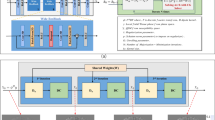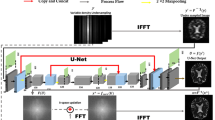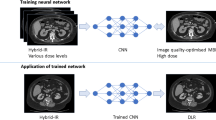Abstract
Objectives
Susceptibility-weighted imaging (SWI) is crucial for the characterization of intracranial hemorrhage and mineralization, but has the drawback of long acquisition times. We aimed to propose a deep learning model to accelerate SWI, and evaluate the clinical feasibility of this approach.
Methods
A complex-valued convolutional neural network (ComplexNet) was developed to reconstruct high-quality SWI from highly accelerated k-space data. ComplexNet can leverage the inherently complex-valued nature of SWI data and learn richer representations by using complex-valued network. SWI data were acquired from 117 participants who underwent clinical brain MRI examination between 2019 and 2021, including patients with tumor, stroke, hemorrhage, traumatic brain injury, etc. Reconstruction quality was evaluated using quantitative image metrics and image quality scores, including overall image quality, signal-to-noise ratio, sharpness, and artifacts.
Results
The average reconstruction time of ComplexNet was 19 ms per section (1.33 s per participant). ComplexNet achieved significantly improved quantitative image metrics compared to a conventional compressed sensing method and a real-valued network with acceleration rates of 5 and 8 (p < 0.001). Meanwhile, there was no significant difference between fully sampled and ComplexNet approaches in terms of overall image quality and artifacts (p > 0.05) at both acceleration rates. Furthermore, ComplexNet showed comparable diagnostic performance to the fully sampled SWI for visualizing a wide range of pathology, including hemorrhage, cerebral microbleeds, and brain tumor.
Conclusions
ComplexNet can effectively accelerate SWI while providing superior performance in terms of overall image quality and visualization of pathology for routine clinical brain imaging.
Key Points
• The complex-valued convolutional neural network (ComplexNet) allowed fast and high-quality reconstruction of highly accelerated SWI data, with an average reconstruction time of 19 ms per section.
• ComplexNet achieved significantly improved quantitative image metrics compared to a conventional compressed sensing method and a real-valued network with acceleration rates of 5 and 8 (p < 0.001).
• ComplexNet showed comparable diagnostic performance to the fully sampled SWI for visualizing a wide range of pathology, including hemorrhage, cerebral microbleeds, and brain tumor.





Similar content being viewed by others
Abbreviations
- CMBs:
-
Cerebral microbleeds
- CNN:
-
Convolutional neural network
- ComplexNet:
-
Complex-valued convolutional neural network
- CS:
-
Compressed sensing
- GRE:
-
Gradient echo
- MARS:
-
Microbleed Anatomical Rating Scale
- PSNR:
-
Peak signal-to-noise ratio
- R :
-
Acceleration rate
- RealNet:
-
real-valued convolutional neural network
- SSIM:
-
Structural similarity
- SWI:
-
Susceptibility-weighted imaging
References
Liu C, Li W, Tong KA, Yeom KW, Kuzminski S (2015) Susceptibility-weighted imaging and quantitative susceptibility mapping in the brain. J Magn Reson Imaging 42:23–41
Conklin J, Longo MGF, Cauley SF et al (2019) Validation of highly accelerated wave–CAIPI SWI compared with conventional SWI and T2*-weighted gradient recalled-echo for routine clinical brain MRI at 3T. AJNR Am J Neuroradiol 40:2073–2080
Haller S, Haacke EM, Thurnher MM, Barkhof F (2021) Susceptibility-weighted imaging: technical essentials and clinical neurologic applications. Radiology 299:3–26
Bilgic B, Ye H, Wald LL, Setsompopa K (2017) Simultaneous time interleaved multislice (STIMS) for rapid susceptibility weighted acquisition. Neuroimage 155:577–586
Yaman B, Hosseini SAH, Moeller S, Ellermann J, Uğurbil K, Akçakaya M (2020) Self-supervised learning of physics-guided reconstruction neural networks without fully-sampled reference data. Magn Reson Med 84:3172–3191
Cole E, Cheng J, Pauly J, Vasanawala S (2021) Analysis of deep complex-valued convolutional neural networks for MRI reconstruction and phase-focused applications. Magn Reson Med 86:1093–1109
Chung MS, Lee EJ, Kim S, Kim SO, Byun JS (2020) Wave-CAIPI susceptibility-weighted imaging achieves diagnostic performance comparable to conventional susceptibility-weighted imaging in half the scan time. Eur Radiol 30:2182–2190
Chen F, Taviani V, Malkiel I et al (2018) Variable-density single-shot fast spin-echo MRI with deep learning reconstruction by using variational networks. Radiology 289:366–373
Duan C, Deng H, Xiao S et al (2019) Fast and accurate reconstruction of human lung gas MRI with deep learning. Magn Reson Med 82:2273–2285
Shanbhogue K, Tong A, Smereka P et al (2021) Accelerated single-shot T2-weighted fat-suppressed (FS) MRI of the liver with deep learning–based image reconstruction: qualitative and quantitative comparison of image quality with conventional T2-weighted FS sequence. Eur Radiol. https://doi.org/10.1007/s00330-021-08008-3
Dedmari MA, Conjeti S, Estrada S, Ehses P, Stöcker T, Reuter M (2018) Complex fully convolutional neural networks for MR image reconstruction. Proceedings of first international workshop, machine learning for medical image reconstruction (MLMIR), at MICCAI 30–38
Wang S, Cheng H, Ying L et al (2020) DeepcomplexMRI: Exploiting deep residual network for fast parallel MR imaging with complex convolution. Magn Reson Imaging 68:136–147
El-Rewaidy H, Neisius U, Mancio J et al (2020) Deep complex convolutional network for fast reconstruction of 3D late gadolinium enhancement cardiac MRI. NMR Biomed 33:e4312
Gao Y, Cloos M, Liu F, Crozier S, Pike GB, Sun H (2021) Accelerating quantitative susceptibility and R2* mapping using incoherent undersampling and deep neural network reconstruction. Neuroimage 240:118404
Sun H, Cleary JO, Glarin R et al (2020) Extracting more for less: multi-echo MP2RAGE for simultaneous T1-weighted imaging, T1 mapping, R2* mapping, SWI, and QSM from a single acquisition. Magn Reson Med 83:1178–1191
Liu F, Samsonov A, Chen L, Kijowski R, Feng L (2019) SANTIS: Sampling-augmented neural network with incoherent structure for MR image reconstruction. Magn Reson Med 82:1890–1904
Schlemper J, Caballero J, Hajnal JV, Price AN, Rueckert D (2018) A deep cascade of convolutional neural networks for dynamic MR image reconstruction. IEEE Trans Med Imaging 37:491–503
Duan C, Deng H, Xiao S et al (2021) Accelerate gas diffusion-weighted MRI for lung morphometry with deep learning. Eur Radiol. https://doi.org/10.1007/s00330-021-08126-y
Kingma DP, Ba J (2014) Adam: a method for stochastic optimization. https://arxiv.org/abs/1412.6980. Accessed 22 Dec 2014
Chan KS, Marques JP (2021) SEPIA-susceptibility mapping pipeline tool for phase images. Neuroimage 227:117611
Lustig M, Donoho D, Pauly JM (2007) Sparse MRI: the application of compressed sensing for rapid MR imaging. Magn Reson Med 58:1182–1195
Wang Z, Bovik AC, Sheikh HR, Simoncelli EP (2004) Image quality assessment: from error visibility to structural similarity. IEEE Trans Image Process 13:600–612
Chung MS, Lee EJ, Kim S, Kim SO, Byun JS (2020) Wave-CAIPI susceptibility-weighted imaging achieves diagnostic performance comparable to conventional susceptibility-weighted imaging in half the scan time. Eur Radiol 30:2182–2190
Gregoire S, Chaudhary U, Brown M et al (2009) The microbleed anatomical rating scale (MARS) reliability of a tool to map brain microbleeds. Neurology 73:1759–1766
Ahn S, Park SH, Lee KH (2013) How to demonstrate similarity by using noninferiority and equivalence statistical testing in radiology research. Radiology 267:328–338
Tanenbaum LN, Tsiouris AJ, Johnson AN et al (2017) Synthetic MRI for clinical neuroimaging: results of the magnetic resonance image compilation (MAGiC) prospective, multicenter, multireader trial. AJNR Am J Neuroradiol 38:1103–1110
Antun V, Renna F, Poon C, Adcock B, Hansen AC (2020) On instabilities of deep learning in image reconstruction and the potential costs of AI. Proc Natl Acad Sci U S A 117:30088–30095
Sandino CM, Cheng JY, Chen F, Mardani M, Pauly JM, Vasanawala SS (2020) Compressed sensing: from research to clinical practice with deep neural networks. IEEE Signal Process Mag 37:111–127
Liu S, Buch S, Chen Y et al (2017) Susceptibility-weighted imaging: current status and future directions. NMR Biomed 30:e3552
Zhang Z, Romero A, Muckley MJ, Vincent P, Yang L, Drozdzal M (2019) Reducing uncertainty in undersampled MRI reconstruction with active acquisition. Proceedings of the IEEE conference on computer vision and pattern recognition 2049–2058
Edupuganti V, Mardani M, Vasanawala S, Pauly J (2020) Uncertainty quantification in deep MRI reconstruction. IEEE Trans Med Imaging 40:239–250
Mardani M, Gong E, Cheng JY et al (2018) Deep generative adversarial neural networks for compressive sensing MRI. IEEE Trans Med Imaging 38:167–179
Ledig C, Theis L, Huszár F, Caballero J, Cunningham A (2017) Photorealistic single image super-resolution using a generative adversarial network. Proceedings of the IEEE conference on computer vision and pattern recognition 4681–4690
Quan TM, Nguyen-Duc T, Jeong WK (2018) Compressed sensing MRI reconstruction using a generative adversarial network with a cyclic loss. IEEE Trans Med Imaging 37:1488–1497
Yang Q, Yan P, Zhang Y et al (2018) Low-dose CT image denoising using a generative adversarial network with Wasserstein distance and perceptual loss. IEEE Trans Med Imaging 37:1348–1357
Funding
This study has received funding by the National Natural Science Foundation of China (81825012, 81730048, 81625011).
Author information
Authors and Affiliations
Corresponding author
Ethics declarations
Ethics approval
Institutional Review Board approval was obtained.
Informed Consent
Written informed consent was obtained from all subjects (patients) in this study.
Conflict of Interest
The authors of this manuscript declare no relationships with any companies whose products or services may be related to the subject matter of the article.
Guarantor
The scientific guarantor of this publication is Xin Lou, MD.
Statistics and Biometry
One of the authors has significant statistical expertise.
Methodology
• Prospective
• Observational
• Performed at one institution
Additional information
Publisher’s note
Springer Nature remains neutral with regard to jurisdictional claims in published maps and institutional affiliations.
Supplementary information
ESM 1
(DOCX 748 kb)
Rights and permissions
About this article
Cite this article
Duan, C., Xiong, Y., Cheng, K. et al. Accelerating susceptibility-weighted imaging with deep learning by complex-valued convolutional neural network (ComplexNet): validation in clinical brain imaging. Eur Radiol 32, 5679–5687 (2022). https://doi.org/10.1007/s00330-022-08638-1
Received:
Revised:
Accepted:
Published:
Issue Date:
DOI: https://doi.org/10.1007/s00330-022-08638-1




